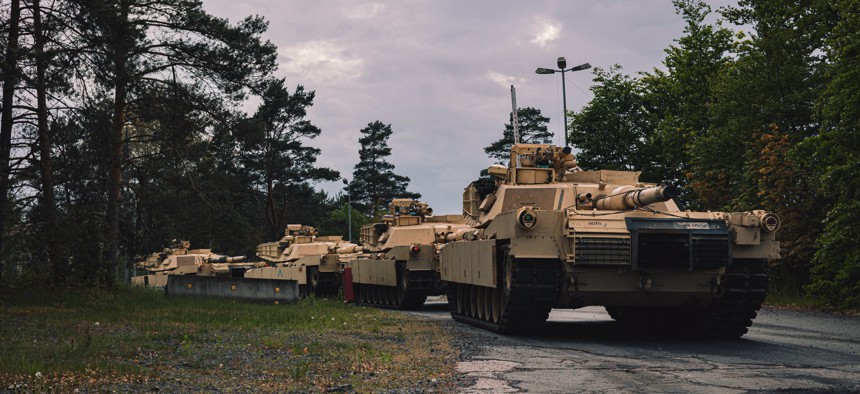
U.S. M1A1 Abrams tanks needed for training the Armed Forces of Ukraine await transport to training areas at Grafenwoehr, Germany, May 14, 2023. U.S. Army / Spc. Christian Carrillo
What about Ukraine’s Abrams tanks?
Recent losses underscore the importance of doctrine and training—not just weapons—in war.
In early March, press reports of the battle at Berdychi, five miles northwest of Avdiivka, asserted that the Ukrainian 47th Mechanized Brigade lost three M1A1 Abrams main battle tanks, at least four M2A2 Bradley Fighting Vehicles, and two Assault Breacher Vehicles in combat there. These losses represent 10 percent of the brigade’s tanks, five percent of its infantry fighting vehicles and about one-third of its armored engineer vehicles.
In late March, independent visual reporting confirmed four destroyed Abrams tanks in the vicinity of Avdiivka. Make that 12.9 percent of Ukraine’s Abrams lost in one battle.
However. these reports also said the capture of the rubble of Avdiivka cost the Russians “at least 16,000 dead, probably tens of thousands of wounded and nearly 800 armored vehicles.” Vague reports of Ukrainian losses suggest a few thousand killed, thousands more wounded, and fewer than 100 armored vehicles lost. The Ukrainians claimed the battle effectively halted the advance of the Russian 2nd and 41st Combined Arms Armies.
The M1A1 Abrams figured prominently, albeit not in detail, in these news accounts of Avdiivka and Berdychi. Such reports will likely feature prominently in Ukrainian President Volodymyr Zelenskyy’s next series of demands for more U.S. and European financial and material support.
But the Ukraine war persists in begging the question: are advanced weapons like the M1A1 Abrams truly force multipliers in Ukraine? Or are they destined to be lost and abandoned on the battlefield?
While many defense pundits wax eloquently about the technological sophistication of Western combat vehicles, the Forecast International Weapons Group once again maintains technology alone is not the key to modern armored warfare. How these weapons are employed tactically is, and always will be, the key factor.
Both the Ukrainian and Russian armies have exhibited a remarkable lack of aptitude, let alone inclination, to properly exploit the potential of advanced weapons on the battlefield in Ukraine. This is not surprising, however, as both armies provide a mirror image of each other in terms of modern tactical sophistication...or, more precisely, the lack thereof.
If the Western combat vehicles in Ukraine, such as the Abrams, are employed with crews and commanders well-grounded in Western armored warfare doctrine, the impact on the battlefield could be devastating for Russian forces. But if Ukrainian forces insist on employing these Western weapon systems according to their existing Soviet-style doctrine, the results on the battlefield will remain mixed at best, disastrous at worst. Even the most sophisticated weapon in the world is utterly useless in untrained (or poorly trained) hands.
Sadly, as the slaughter in and around Avdiivka and Berdychi reflect, continues to indicate the Ukrainians have NOT embraced Western armored combat doctrine. Indeed, the Ukrainians are still operating in the same discredited Russian mode.
Technology does not win battles. Properly trained soldiers win battles.

